Can a Midsize Three-Row SUV Get Any Better?
The 2026 Hyundai Palisade has set the new bar for midsize three-row SUVs. When Hyundai first introduced the Palisade in 2020, the reviews were nearly unanimous in praise for its design, features and value. The 2026 Palisade is an all-new look at what has been one of the most popular SUVs on the market.

Hyundai brought automotive journalists to Calistoga to the beautiful Napa Valley to drive the all-new Palisade. Our base of operation was the Solage Resort & Spa, located on the famous Silverado Highway, which gave us access to flat and mountain vineyard drive routes that eventually led us to the Pacific Ocean. It was a long but scenic day of driving that revealed the excellent ride and handling attributes of the 2026 Palisade.
One Engine, One Transmission, Front or All-Wheel Drive
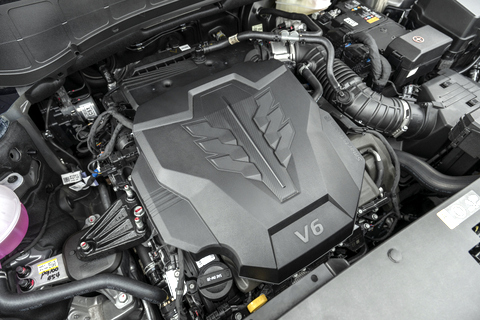
The 2026 Hyundai Palisade comes with a naturally aspirated 3.5-liter V6 putting out 287 horsepower and 260 pound-feet of torque. The engine is mated to an 8-speed automatic, with paddle shifters and three driver-selectable drive modes on the front-wheel drive (FWD) trim or six for the all-wheel drive (AWD). Front-wheel drive is standard, with the on-demand AWD system, which Hyundai calls HTRAC, a $2,000 premium. This engine and transmission combination is the only one available on all seven Palisade trim levels—SE, SEL, SEL Premium, SEL Convenience, XRT Pro, Limited and Calligraphy.
Fuel economy at 19 mpg city/25 highway/21 combined for the FWD and 18/24/20 for the AWD are very respectable for a vehicle weighing 4,420-4,575 pounds. To aid in fuel economy the Palisade has the stop-and-go feature, where the engine shuts off when coming to a stop and restarts automatically. Hyundai’s system was smooth and quiet when restarting, which can’t be said about others we have tested.
Heading Out – On Road
A key attribute of a vehicle’s handling and ride is how it deals with bumps, swells and rises in the road. What you looking at is how many times a vehicle bounces on the shocks and struts before leveling back to its normal ride stance. Our drive took us on two-lane rural roads, many of which were curvy with undulations, at speeds averaging 45 miles per hour. Sometimes when both lateral and vertical changes hit at the same time it made it tricky to keep the car under control.
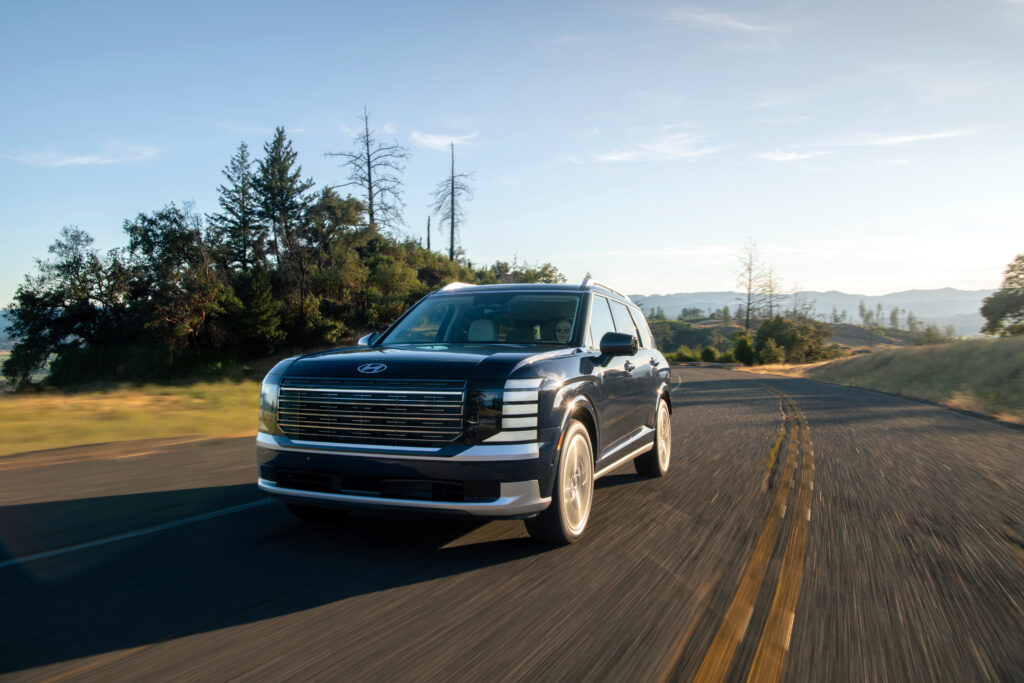
Hyundai engineers have designed the suspension that, when going through an up-and-down section of a road, the Palisade lifts and drops only one time. The significance of this quick and smooth rebound is the driver retains maximum control of the steering and brakes sooner as all four tires are firmly on the ground. We were very impressed not only with this, but also the overall ride, which was controlled and composed with little-to-no body roll.
To get the most street performance and efficiency, the Palisade has drive modes of Eco, Sport and My Drive. We spent most of our time in the Eco mode as it squeezes-out every last drop of fuel. When needing more oomph, we went for Sport, which held the transmission a bit longer in each rev band. We also took advantage of the steering wheel paddles by pulling back on the left side paddle to manually shift into a lower gear, which would stay there until pulling on the right side paddle to go back up through the gears. Acceleration was smooth and quiet as the non-turbocharged V6 went through the 8-speed transmission with little notice of gear changes.
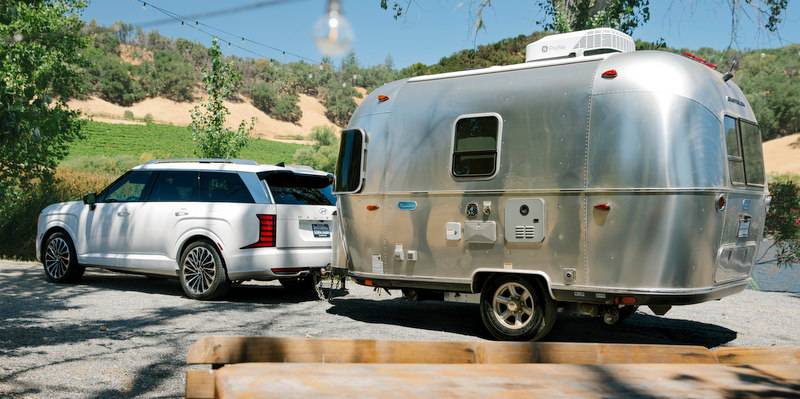
Stops were solid with a power-assisted braking system consisting of vented front and solid rear discs as part of the anti-lock brake system. The Palisade Calligraphy trim (as do the Limited and XRT) came with a Trailering Package that includes 7-pin pre-wiring, a transmission oil cooler, trailer hitch, trailer brake controller, sway control and a tow rating of 5,000 pounds. If equipped without the trailer brakes, the towing maximum is 1,650 pounds.
Heading Out – Off-Road and Getting Dirty
Our road drive was broken-up with lunch and some off-roading at the Lago de Merlo Vineyards & Winery in Healdsburg. Hyundai expertly cut an off-road course where the specially designed Palisade XRT Pro could be put through its paces. My drive partner and I drove the course multiple times, getting a feel for the XRT Pro capabilities. It handled steep ascent and descents on sandy, loose soil with ease as well as slow attacks of deep ruts and a jagged rock field. The XRT Pro is designed for mild off-road adventures, but certainly not rock climbing.
The Palisade XRT Pro came from Hyundai’s Irvine Design studio, where the team was led by Soo Min Choe, exterior creative design manager, Hyundai Design North America. Soo Min told us the Palisade XRT Pro has three design themes of “protection, connection and functionality” that are keys to it also delivering “capability and appearance.” To achieve these goals, the XRT Pro has been beefed-up with these off-roading features.
- HTRAC all-wheel drive – standard
- Drive modes of Mud, Sand and Snow
- Continental CrossContact GT 19-inch 255/60 all-terrain tires
- 8.4-inches of ground clearance (vs. 7.4-inches standard on other Palisade trims)
- Electronic rear limited slip differential
- Downhill Assist
- Higher approach and departure angles
- Front and rear red fully functional recovery hooks
- Real-time pitch & roll compass
- Surround and ground view monitor displays
Some of the design cues that identify the XRT Pro are “XRT Pro rear badging, dark exterior accents on the grille, window surround and cladding, 115-volt power outlet and the dark-finish alloy 18-inch alloy wheels.
Exterior: No Hard Edges
Design changes on the company’s flagship model include elements of the grille, front and rear fascia, exterior door finishes and wheels. The wide cascading grille shouts premium with a unique lighting signature of LED headlamps and daytime running lights. As does the long hood and the nearly flat roof, with chrome rack rails and an integrated spoiler to offer shading over the rear hands-free power lift gate. Front and rear overhangs are very short. The no hard edges design resulted in a 0.31 drag coefficient.
Available in nine exterior colors the rear features the letters P-A-L-I-S-A-D-E spread-out between the vertical rectangular LED tail lights. Chrome is used at a tasteful minimum.
Interior: The Ultimate Family SUV
Even the base trim Palisade SE has the look and feel of a far more pricy SUV. Go up to the top Calligraphy trim like we drove, and the experience is far more than is to be expected in a seven-/eight-seat family hauler.
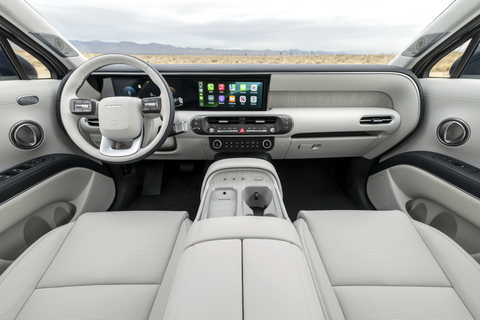
The overall trim quality, including design, function, materials and textures, is very high in the Palisade Calligraphy. Hyundai tells us the Palisade has “premium-designed space…that is opulent with grandness” with the seats inspired by premium furniture. Based on the trim level, seats are covered in cloth, H-Tex (leatherette) or Nappa leather, have power adjustments including lumber, are heated, ventilated, have memory—and even a relaxation mode in the Ergo-Motion seats. The suede headliner in the Calligraphy added a touch of class and elegance.
The interior has an abundance of premium soft touch materials. The leatherette-wrapped dash compliments the perforated, heated and ventilated leather front seats. The driver and passenger get 8-way power adjustments, including lumbar, leg cushion extensions and memory. Ambient lighting on the door trim and center console accents the interior. The power sunroof opens the world to the first and second rows.
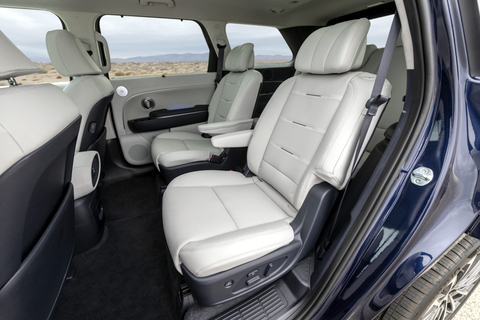
The Palisade can seat up to eight if ordered with the second-row bench seat. Clean Fleet Report drove the 2026 Palisade Calligraphy with the second-row Captain’s Chairs, making it a seven-passenger cabin. The two middle seats were not only heated, but ventilated, something only found on luxury vehicles. The second-row passengers have manual side window shades, USB-C power ports, cup holders and excellent head and leg room. The second row seats recline and also have a one-touch slide forward operation, which provides access to a third row, which can easily accommodate two full-size adults—three in a pinch. The rear-most seat has USB-C power ports, ceiling mounted air vents, cup holders and fixed glass roof.
When it is time to pack the bags or do some serious hauling, there is 19.1 cubic feet behind the third-row seats, 46.3 behind the second-row seats, and 86.7 with all the seats laid flat. The far rear cargo area has a security storage area in the floor.
Thanks to sound deadening material placed between the cabin and engine, acoustic glass on the windshield and side windows and the optional carpeted floor mats, the cabin in the 2026 Palisade is an impressively quiet environment.
Technology
That quiet is a good thing when listening to the Bose sound audio system, standard on the XRT Pro, Limited and Calligraphy. The 12.3-inch color touchscreen made listening easy as it met Clean Fleet Report’s minimum requirement for a driver-friendly system with knobs for the channel and volume functions. Sounds came from AM/FM HD and SiriusXM satellite radio, wireless Apple CarPlay and Android Auto. The listening suite was completed with Bluetooth streaming audio and USB-C data and charge ports. The voice recognition for hands-free telephone dialing worked perfectly.
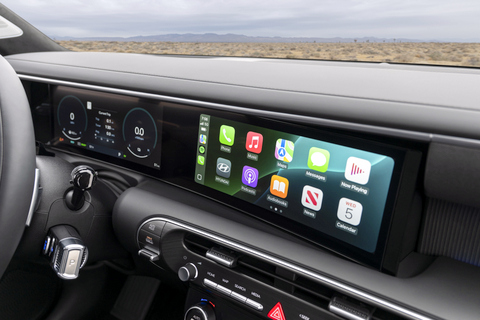
The 12-inch color head-up display allows drivers to keep their eyes on the road while vital information, such as speed, speed limit signs, radio channel and turn-by-turn navigation, is projected onto the windshield.
The 2026 Palisade Calligraphy trim level includes premium and convenience futures such as rain sensing windshield wipers and a 12.3-inch digital instrument cluster with an easy-to-read speedometer and tachometer with white lettering on a black background. The heated, leather-wrapped steering wheel has audio, telephone and cruise controls.
The Palisade is equipped with an integrated dash cam that records front and rear when driving or parked. Footage is stored on an on-board SD card with a 512GB capacity.
Safety and Convenience
The 2026 Palisade comes with 10 airbags (front, seat-mounted, driver knee, and full side curtain) and advanced driver-assistance systems (ADAS). Safety features included forward collision warning and avoidance, lane departure and driver attention warning, lane keep assist, blind spot collision avoidance, rear view camera with surround vision, rear cross traffic collision and parking distance warning, and pedestrian forward collision avoidance.
Pricing and Warranties
The 2026 Palisade comes in seven trim levels, all of which optional all-wheel drive, except XRT Prop where it is standard. These are the base prices before options, but including the $1,495 freight charge.
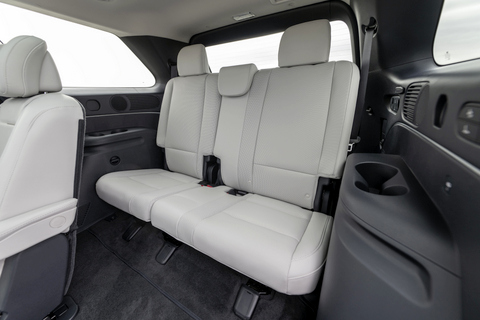
- SE $40,430
- SEL $42,935
- SEL Convenience $44,365
- SEL Premium $46,285
- XRT Pro $50,865
- Limited $50,765
- Calligraphy $55,555
The 2026 Palisade comes with these warranties.
- Powertrain – 10 years/100,000 miles
- New Vehicle – Five years/60,000 miles
- Roadside – Five years/Unlimited miles
- Anti-Perforation – Seven years/Unlimited miles
Observations: 2026 Hyundai Palisade
After spending several hours in the 2026 Hyundai Palisade Calligraphy AWD, it became clear this may be the premier seven- or eight-seat midsize SUV. Clean Fleet Report doesn’t lightly throw around the term luxury, but Hyundai is clearly and confidently challenging the luxury brands. Fully equipped at $55,555, the top trim Calligraphy easily is the value proposition for premium midsize SUVs.
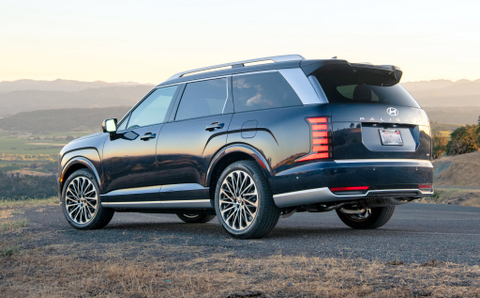
The Palisade is an excellent three-row SUV. Interior roominess, ride comfort, premium build and materials, a long list of convenience features, easy-to-use infotainment system and, of course, the comprehensive warranty, are only some of the reasons Hyundai is confident holding the Palisade up against the competition.
But wait, there’s more. The fuel economy is respectable for a vehicle of this size, weight and purpose, but Hyundai has announced a Palisade Hybrid will be introduced later in 2025.
Make sure to opt-in to the Clean Fleet Report newsletter (top right of page) to be notified of all new stories and vehicle reviews.
Story by John Faulkner. Photos by John Faulkner and Hyundai.

Disclosure
Clean Fleet Report is loaned free test vehicles from automakers to evaluate, typically for a week at a time. Our road tests are based on this one-week drive of a new vehicle. Because of this we don’t address issues such as long-term reliability or total cost of ownership. In addition, we are often invited to manufacturer events highlighting new vehicles or technology. As part of these events we may be offered free transportation, lodging or meals. We do our best to present our unvarnished evaluations of vehicles and news irrespective of these inducements.
Our focus is on vehicles that offer the best fuel economy in their class, which leads us to emphasize electric cars, plug-in hybrids, hybrids and other efficient powertrains. We also feature those efficient gas-powered vehicles that are among the top mpg vehicles in their class. In addition, we aim to offer reviews and news on advanced technology and the alternative fuel vehicle market. We welcome any feedback from vehicle owners and are dedicated to providing a forum for alternative viewpoints. Please let us know your views at [email protected] or by commenting on any of our stories. We answer every comment!
The post Flash Drive: 2026 Hyundai Palisade first appeared on Clean Fleet Report.

